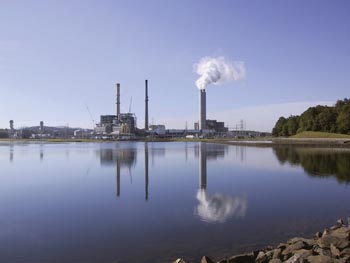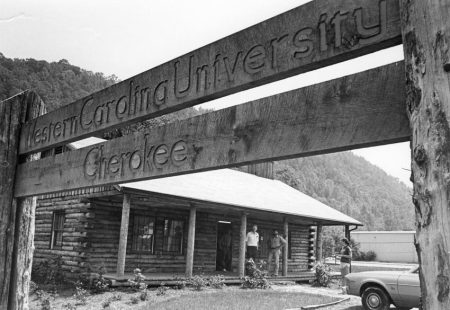Another Power Plant in Our Future?
 |
| Water vapor rises from scrubber towers at the Progress Energy Lake Julian power plant. Photo: Courtesy of Progress Energy |
Electricity is like tap water, so taken for granted that most of us are aware of it only when it’s not there.
by Michael Hopping
But the invisibility of reliable power has a downside. When there’s a problem behind the scenes, power companies can have a hard time getting our attention. In Asheville and surrounding areas this is one of those times.
On cold winter mornings we use more electricity than the 867 megawatts (MW) Progress Energy is able to produce locally. That was already the case almost three years ago when public opposition and the Woodfin Planning and Zoning Board shot down the company’s plan to build a new peak power plant in Woodfin.
Since then the gap between homegrown generation and consumption has
widened dramatically. On the morning of January 16, 2009, peak demand
exceeded 1050 MW, a number Progress didn’t expect until about 2015.
For now, Progress is able to import the needed power — bought at
premium prices — from outside the area. The contracts expire in three
years and may be extended for one more. After that, who knows?
Supply and Demand
The 20th-century answer to problems like this was simple:
build a new fossil fuel power plant. That’s what Progress tried to push
through at Woodfin. But global warming and a host of other factors are
forcing a rethinking of this historic solution.
It can’t go on being about selling ever more electricity
produced from coal or other fossil fuels. Nuclear power is scary
expensive, even apart from debates about radiation, spent fuel, etc.
Alternative power sources cost less, but sun and wind aren’t a total
answer either. Power dispatchers in Raleigh can’t turn on the sun or
make the wind blow on demand.
At the moment, the network of power plants and transmission
lines we know as “the grid” has very little capacity to store power for
later use. There aren’t any giant batteries to call on. Voltage has to
be regulated minute by minute by dispatchers who turn generating
stations on or off to balance the amount of electricity customers are
using. If there’s too much juice, equipment may get toasted; too little
and the lights go dim.
Demand Side Management
Instead of balancing the energy equation only by changing the
supply side, why not also influence demand? Our problem, for example,
is jumps in the amount of electricity consumed on frigid mornings when
people are getting up and businesses are preparing to open. These
demand spikes, also known as peak demand, are handled by feeding more
power into the lines. But it’s also possible to blunt spikes by turning
some things off.
There’s truth in the saying that “the cheapest watt is the one
you don’t use.” Progress cut the power bill in its own WNC facilities
last year by an average of 20.8% by doing things as simple as turning
off lights and closing bay doors when not in use. Residential customers
are charged 9.634-10.634 cents per kilowatt hour, depending on the
month. The cost of energy efficiency programs averages 2-3 cents per
kilowatt saved, measured over the lifetime of the improvements.
Better insulation, Energy Star appliances, compact fluorescent
lightbulbs and several other efficiency measures reduce electric
consumption across the board, not only at times of peak demand. State
and federal tax credits along with new incentives from Progress
encourage efficiency upgrades.
The company’s EnergyWise program specifically targets demand
spikes. Residential customers are paid to allow Progress to cycle
electric heat, hot water, and air conditioning systems off and on at
times of peak demand. This “demand side management” is an early step
toward the interactive electric grid of tomorrow. Planners hope one day
to have all parts of it — from traditional power stations and wind
farms to household appliances — talking to each other and working
together.
The Alternative to a New Power Plant
The amount of electricity saved by Progress incentive programs
depends on customer participation. More broadly, unless WNC residents
reduce demand spikes by 20-25% (200-250 MW) within the next few years,
Progress is highly likely to propose another peaking power plant in
someone’s neighborhood.
Are savings of this magnitude reasonable? Yes. The average North
Carolinian uses twice as much electricity as an average Californian.
That’s overall use, not peak demand. Reducing peak demand is easier.
Running the clothes dryer during off-peak hours cuts peak demand but
has no effect on total power use.
Progress officials from CEO Lloyd Yates on down insist that
they’d rather not build another plant. Following the Woodfin defeat,
Progress selected a group of local leaders to advise it on how to
promote energy efficiency and conservation. The Community Energy
Advisory Council (CEAC) has met regularly since then. While the group
has much to be proud of, reductions in peak demand are not among them.
WNC is almost 100 MW deeper in the hole now than when the council was
formed. Sam Waters, Progress Energy’s Director of System Planning,
attributed the increase to population growth and higher per capita use.
CEAC isn’t the only game in town. Ned Doyle, coordinator of the
Southern Energy and Environment Expo (this year’s expo takes place on
August 21-23 at the WNC Agricultural Center), is launching “250
MegaWatts of Community Action.” Progress has partnered with Doyle on
the project, which intends to engage the community in reducing
electricity consumption by 250 megawatts. For details on this and
Progress Energy’s efficiency programs see www.seeexpo.com/about/250megawatts.htm .
Our area continues to grow. It remains to be seen whether we can
summon the foresight and will to keep the peak power equation balanced
without another Progress attempt to solve the problem the old-fashioned
way.








